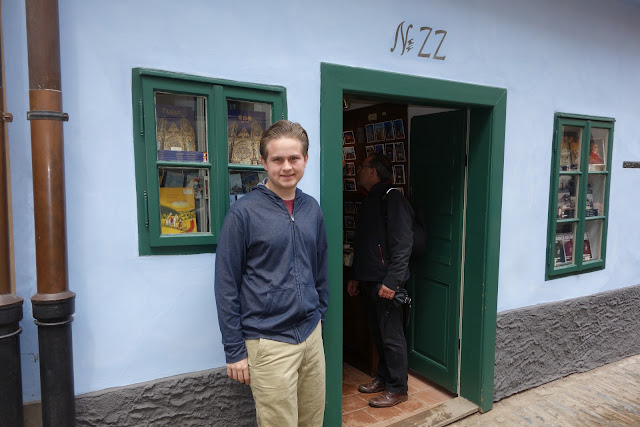The Czech Republic
The nation of Czechoslovakia-formed after WWI, and
dominated by the USSR after WWII-split on January 1, 1993, into two separate
nations: the Czech Republic and
Slovakia. The country has 10.3 million
people, is similar in size to the state of Maine, and about 90% are ethnic
Czechs, who speak Czech. Some major money
makers for the country are machine parts, car and trucks, and beer. More than one third of trade is with
next-door-neighbor Germany. The currency
is called the Czech crown, and 17=$1.
 |
| The view off our balcony, St. Vitus Cathedral is the focal point. |
Prague
No other place in Europe has become so popular so quickly. Prague - the only Central European capital to
escape the bombs of the last century’s wars - is one of Europe’s best-preserved
cities. The Vltava River divides the
west side (Castle Quarter and Little Quarter) from the east side (New Town, Old
Town & Jewish Quarter), with many bridges to walk across.
 |
| St. Vitus in the background, with three lovely ladies enjoying the scenery. |
Our first stop was St. Vitus Cathedral (Katedrála Sv. Víta), a Roman Catholic cathedral containing the tombs and relics of the most important local saints and kings, including the first three Habsburg kings. Started in 1344, construction was stalled by wars and plagues. It was finished in 1929 for the 1,000th anniversary of the death of St. Wenceslas. It is both Gothic and Neo-Gothic, with two distinct halves: the original 14th century Gothic around the high altar, and the modern Neo-Gothic nave. Beautiful and meaningful stained glass windows were center stage. An entire blog could be dedicated to the symbolism behind every window, but we will not be covering that ;-)

Next we entered the Old Royal Palace (Starý Královský
Palác), which was the seat of the Bohemian princes starting in the 12th
century. In 1618, angry Czech Protestant
nobles poured into the governing rooms of the castle and threw the two Catholic
governors out of the window. An old law
actually permits defenestration – throwing people (usually bad politicians) out
of windows when necessary. The two
governors landed – fittingly – in a pile of horse manure. Even though they suffered only broken arms
and bruised egos, this event kicked off the huge Thirty Years’ War that John
mentioned in our Rothenburg post.
Golden Lane, which is a street of old buildings near the
castle, was a favorite for William as it had a rather large exhibit of weaponry
and armor. It also boasts the
distinction of a former residence of Franz Kafka, a favorite existentialist
author of John’s. He lived in #22.
 |
| A beautiful view of Prague. |






That stained glass is UNREAL!!! I would have loved to have seen it in person in that I am sure it was even more gorgeous! Hope the weather perks up and again, THANK YOU for the fun it is to view and read the blog! Love it...
ReplyDeleteIt truly was some of the most unique stained glass I have ever seen. We are back in Germany for a day, and it is actually SUNNY! I am so happy to hear you are enjoying the blog. It is a great way for us to document our trip and share it with Ryan and you and everyone else that may or may not be looking at it :-)
ReplyDelete